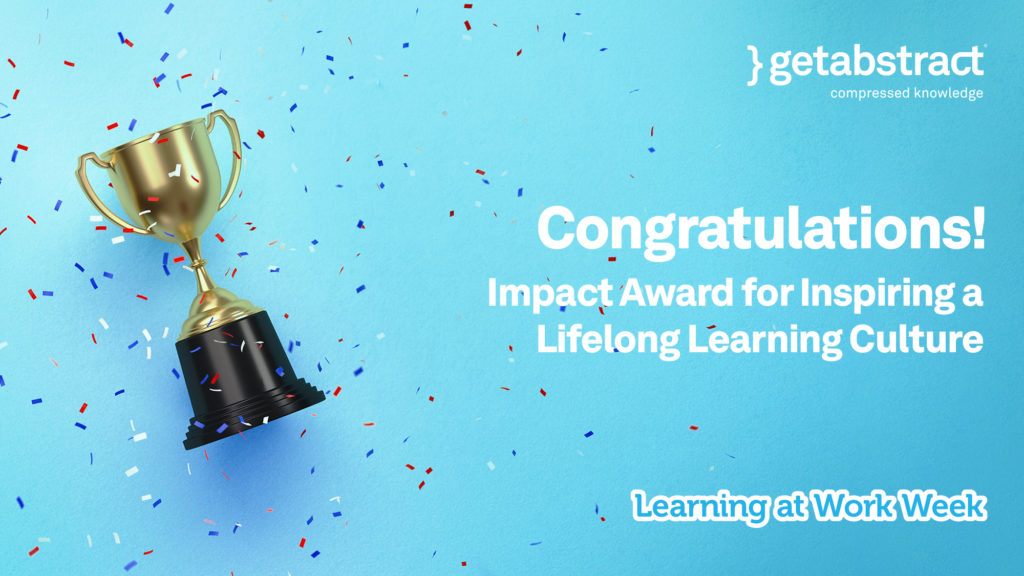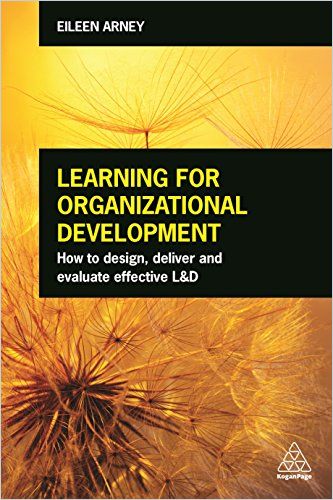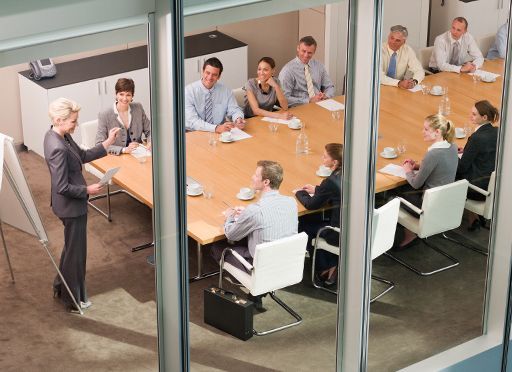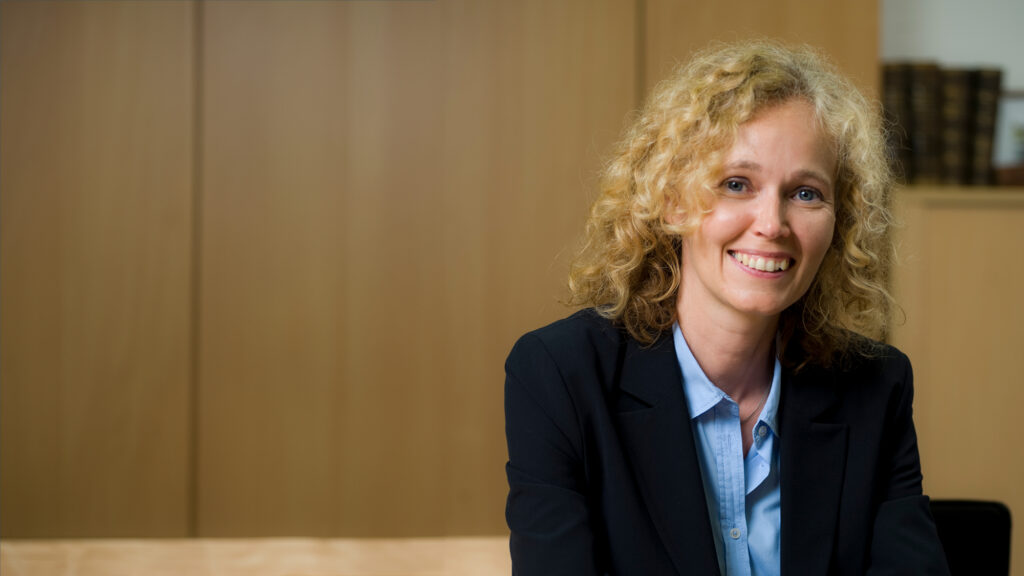“An Opportunity for Our Staff to Share Their Skills”
In a world where the only constant is change, organizations need to stay fast and flexible to keep adapting. The stakes are even higher in a health care environment, where updating skills is critical to good care. St. Andrew’s Hospice in the United Kingdom won the 2020 getAbstract Impact Award for Inspiring a Lifelong Learning Culture in the SME category. By nurturing a learning culture they build organizational agility and the ability to respond quickly to problems as they arise.

Lisa, tell us a little about St Andrew’s Hospice. What is its mission?
Lisa Tillison: The hospice provides services to both adults and children who’ve been diagnosed with life-limiting conditions. We provide support to the patients and their families as well. This includes a range of services including inpatient as well as day care and well-being services. Part of our well-being service offers social events for adults, things like coffee and a chat. So, if we have patients that are socially isolated, we can offer them a space in this group and they can chat with others over a cup of coffee.
So they’re less isolated…
It builds up support for them. We also have things like “capturing memories” as well. So, this might be for the patients who are admitted for end-of-life care, and that could be an individual project for them, or something they do with their families, whatever they choose. We offer relaxation activities, arts and crafts, and we have a gardening group. We also provide symptom management, lymphedema clinics and a bereavement service. We have complementary therapists and therapeutic activities assistants as well. They help with the groups, with relaxation, mindfulness, massage and Reiki therapies. We have a hair salon on site as well, so patients in the hospice can still get their hair done. You know, sometimes it’s really nice to just get your hair done.
And you help the families of your patients too?
One of the things we’ve done in the past is provide a pamper day just for the carers where they come in and get their hair done or have a massage or Reiki treatment, just to give them that little bit of “me time.” But we’re quite focused on holistic care and making sure that it’s not just the patient, it’s the people that are looking after them that are getting some of that support as well.
Tell me, how did you find out about the Impact Award?
As a health care organization, we have a lot of mandatory training that staff need to achieve. This is so we can ensure our patient care is effective and it’s safe. And for those staff who are registered professionals, like the nurses, they have a requirement to maintain their registration. As part of my role here I’m studying for a master’s degree in human resource management, focused on learning and development. I was researching for an assignment and I saw the Campaign for Learning link and found out about Learning At Work. It was a big lightbulb moment for me. I thought:
Wow, this is something that could really make a difference.
Lisa Tillison
Previously we’d done professional development days with the clinical staff, but we hadn’t offered any professional development for other areas of the hospice, and we cover a huge range of areas.
For example?
We’ve got retail staff, catering and household staff, as well as the clinical staff and different areas of administration such as finance, HR and clinical. So just limiting it to clinical staff is not what we need to be doing. It needs to be for everybody. Learning At Work Week was an opportunity to do that, to share the skills within the organization as well. Next, we developed the event with guidance from the Campaign for Learning site.
Wonderful. So what were your main goals for Learning At Work Week?
Well, it was a different way to address the fact that we have a lot of mandatory training that can be quite tedious at times for people, but for me, it was also about trying to change the perception of learning and trying to encourage it, to bring some fun into it and also give an opportunity for our staff to share their skills and their passion for the role they have with their colleagues. Offering an opportunity for our staff to deliver on that was a big part of it.
So, these goals to broaden the mandate to learn into more of a passion to learn really meshed well with your organizational goals.
Yes, it provided more choice. One of our strategic goals is to develop our workforce of the future, so for me, technology is obviously a big part of that. The pandemic brought massive changes in terms of technology for us. So it was about offering bite-size workshops that are easily digestible for people, if that’s the right word, within their learning day, because they’re all busy people.
Of course.
It was about building relationships and collaborations as well, not just with external partners, but with our internal staff too, to give them the confidence, to know that actually, if you’re passionate about something you’re ready to teach it. That’s something I learned while I was a teacher. When somebody first suggested to me a teaching role, I was horrified. But they said to me, if you know a subject, then you can teach it. It’s just how you go about doing that. So providing these steps for people along their own development pathway gave them the confidence to do that.
This was your first Learning At Work Week at St. Andrew’s, right? What was the mix of in-house versus external partners?
Yes, this was our first event. We did bring in external partners to teach some skills, mostly for the clinical aspects of the program; it’s useful to have an external perspective sometimes. And there’s always something to learn. Targeted training that’s aimed at hospice staff is unusual, so by bringing in clinical staff, we were able to ask them to focus it specifically on what we need here. So that was a very positive result.
What main ideas guided you in your programming, besides fulfilling learning mandates?
Because we wanted to make it available to all staff, we looked at a seven-day program, not consecutive. We ran five days, Monday to Friday, and then the following Monday, Tuesday, because our staff work on a rota system. We duplicated some of the sessions to enable them all to attend. That was the focus for us as well, to make sure we gave everybody the opportunity to be there if they chose to.

And what kinds of workshops did you offer?
We offered things like Word and Excel sessions, and Zoom as well, because it was something that was relatively new to us at that point. We also have internal software and a patient record system which we ran sessions on.
We wanted to offer not necessarily refreshers, but opportunities for staff to attend and go and ask questions so that they’re driving the sessions, and it’s more focused for them.
Lisa Tillison
Due to the pandemic, it was important to include well-being for staff. That was a key goal. Within the organization, we’ve got a really good bereavement and support team. They provide support to the patients’ families. They were also able to provide things like self-care and anxiety management workshops. We found those were very useful to the people who attended them.
I’m sure they are, considering the extra burdens of dealing with pandemic.
It’s not going to be everybody that feels they need them, but it’s something that helps to build resilience within the workforce. We had relaxation sessions. We had a Beginner’s Guide to Journaling as well. Again, the aim wasn’t to provide only work-focused sessions. Some of them were personal to people, things that might help them. Things like journaling can help you make sense of things within your own life. And we offered spiritual care sessions as well. So, a full range of things.
And some examples from the more clinical workshops?
Those sessions were around dementia, posture and positioning for patients. We also asked the physiologists to deliver posture for office-based work as well.
Certainly very good information to have for folks working at home.
Also, a workshop around organ donation, falls assessments and safeguarding. So quite a wide range of different things. Some were suitable for all staff, some more suitable just for the clinical staff, and some just for nonclinical staff. We had a key that identified the different sessions for different people.
That sounds quite varied. Lots of interesting choices. How did you get the word out?
We emailed a newsletter-style email. We worked with our communications team to send out things that were visually interesting, that would “pop.” They helped with the planning of the program as well, the way that that looked, so that it was accessible and easy to read. And we use Workplace within the organization, which is similar to Facebook but it’s a business-based platform. We used different things on Workplace that we’ve never used before. While we had a normal booking system with booking forms that people could use in advance, we also used the booking platform on Workplace.
So we were learning along the way too!
Lisa Tillison
We also asked staff to provide us with “learning journeys,” their own learning journeys, because that was the theme of the week. We shared those journeys with everybody as well via Workplace and via email so that people would have the opportunity to see that not everybody was fantastic at school, not everybody was even interested in school. And that sometimes the learning that you pick up along the way is as important as that formal sit-down learning. The intention was to inspire others to go on and try something. One thing we learned was we probably need to promote the event a little bit earlier, which is valuable feedback about how to do it better next time.
And do you feel like you got good engagement?
When we looked at the Workplace statistics at the end of the week, we had the highest engagement we’d ever had on Workplace, so yes. I mean, engagement can always be better, but I didn’t evaluate this only by looking at the numbers. Part of the evaluation was to gauge why people didn’t attend as well as the benefit that people got from attending. Rather than people saying, out of five stars, how good do you think the session was, I asked them to rate the workshops on whether they were useful in their role, whether they were interesting to know, whether they were helpful to them.
But your feedback was generally positive?
Yes it was. The majority of people said that most of it was useful in their role, apart from the self-care. The topics that were not work-focused, those were the things that people found were most helpful to them.
That’s excellent!
Yes, and it helps me to understand what is worth doing or not. Somebody stopped me during the week and she was so excited. She said she was so pleased because the mixture of people on the sessions gave her access to people she wouldn’t normally talk to in her daily work. That mix of people brought different perspectives to the topic that was being discussed and maybe things she wouldn’t have thought of. Her enthusiasm and excitement was catching.
That’s wonderful. I’m assuming that your program was all online, right? What kind of challenges have you had to navigate due to COVID-19?
Yes, it was, and that was a massive learning curve for me. I’ve organized similar things, face-to-face training, as that’s part of my role, but actually making sure that our facilitators were comfortable using Zoom, was something else that we provided support for. We set up Zoom for them and I sat in on those sessions to support them.
It was a huge learning curve for everybody really, to actually deliver this program online, but that’s a result of the pandemic. I don’t necessarily think that’s a bad thing, because in some ways that makes it more accessible to people, and that’s all good.
Lisa Tillison
We have people sitting at home during the relaxation sessions where they’re able to go and sit down or lie on the sofa if that’s what they choose. I think that the challenges for us are around the use of technology and people being at home and how we help them adjust to that. That’s why digital skills were heavily featured.
How has COVID-19 affected hospice care? Are you all locked down?
We’ve made sure that our visiting remains within UK government guidelines, but that people are still able to be with their loved ones. The building is locked down into different zones and staff are only allowed in the zone where they work; they’re not allowed to switch between zones. We have a fantastic catering facility, but we’re not allowed to use that at the moment, so it’s had quite an impact on the social aspect of work.
Now, you had some familiarity with getAbstract through university, is that right?
Yes, and also from Campaign for Learning which had getAbstract’s SketchNotes for Learning At Work Week. But through university I became familiar with getAbstract and the kind of things you offer. It’s fantastic! When you’re doing a master’s, you’ve got so much to read, it’s brilliant to have that quick, short-bullet-points tool.
Any books in particular you would recommend to readers?
One of the books I found really useful is Learning for Organizational Development by Eileen Arney, which I’ve ordered based on the summary, because it covers the whole L&D gambit, from planning and design all the way to evaluation. I think there’s valuable learning within that. It talks about how learning links with your strategic objectives and how and where learning takes place, that it’s not necessarily sitting at a desk or in a classroom. I’m keen to find out more.
That sounds particularly useful. Any others?
One that sticks out for me is The Seven Habits of Highly Effective People. While it’s not focused on learning and development, there’s one habit – “Seek first to understand, then to be understood” – that for me is absolutely the key to teaching people and to learning as well.

Lisa Tillison is the Learning and Development Lead at St. Andrew’s Hospice. It’s her role to help St. Andrew’s staff keep their skills up-to-date. She organized St. Andrew’s Learning At Work Week to support organizational learning and development goals.






